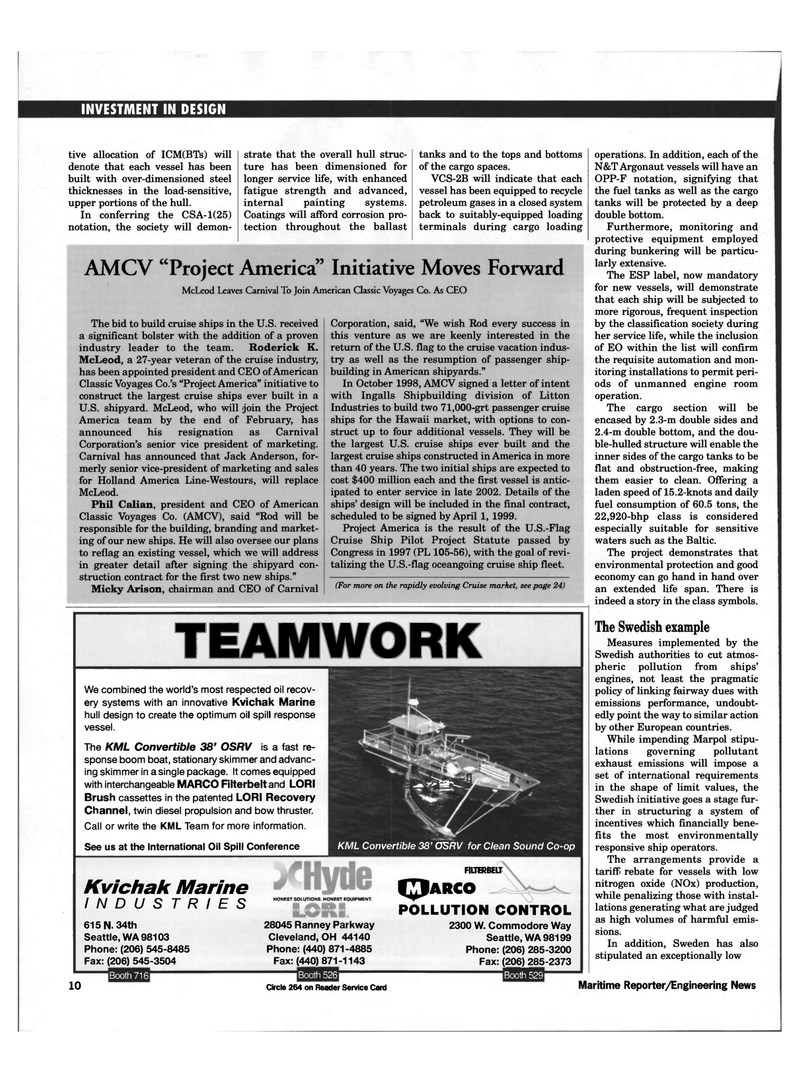
Page 11: of Maritime Reporter Magazine (February 1999)
Read this page in Pdf, Flash or Html5 edition of February 1999 Maritime Reporter Magazine
INVESTMENT IN DESIGN tive allocation of ICM(BTs) will denote that each vessel has been built with over-dimensioned steel thicknesses in the load-sensitive, upper portions of the hull.
In conferring the CSA-1(25) notation, the society will demon- strate that the overall hull struc- ture has been dimensioned for longer service life, with enhanced fatigue strength and advanced, internal painting systems.
Coatings will afford corrosion pro- tection throughout the ballast tanks and to the tops and bottoms of the cargo spaces.
VCS-2B will indicate that each vessel has been equipped to recycle petroleum gases in a closed system back to suitably-equipped loading terminals during cargo loading
AMCV "Project America" Initiative Moves Forward
McLeod Leaves Carnival To Join American Classic Voyages Co. As CEO
The bid to build cruise ships in the U.S. received a significant bolster with the addition of a proven industry leader to the team. Roderick K.
McLeod, a 27-year veteran of the cruise industry, has been appointed president and CEO of American
Classic Voyages Co.'s "Project America" initiative to construct the largest cruise ships ever built in a
U.S. shipyard. McLeod, who will join the Project
America team by the end of February, has announced his resignation as Carnival
Corporation's senior vice president of marketing.
Carnival has announced that Jack Anderson, for- merly senior vice-president of marketing and sales for Holland America Line-Westours, will replace
McLeod.
Phil Calian, president and CEO of American
Classic Voyages Co. (AMCV), said "Rod will be responsible for the building, branding and market- ing of our new ships. He will also oversee our plans to reflag an existing vessel, which we will address in greater detail after signing the shipyard con- struction contract for the first two new ships."
Micky Arison, chairman and CEO of Carnival
Corporation, said, "We wish Rod every success in this venture as we are keenly interested in the return of the U.S. flag to the cruise vacation indus- try as well as the resumption of passenger ship- building in American shipyards."
In October 1998, AMCV signed a letter of intent with Ingalls Shipbuilding division of Litton
Industries to build two 71,000-grt passenger cruise ships for the Hawaii market, with options to con- struct up to four additional vessels. They will be the largest U.S. cruise ships ever built and the largest cruise ships constructed in America in more than 40 years. The two initial ships are expected to cost $400 million each and the first vessel is antic- ipated to enter service in late 2002. Details of the ships' design will be included in the final contract, scheduled to be signed by April 1, 1999.
Project America is the result of the U.S.-Flag
Cruise Ship Pilot Project Statute passed by
Congress in 1997 (PL 105-56), with the goal of revi- talizing the U.S.-flag oceangoing cruise ship fleet. (For more on the rapidly evolving Cruise market, see page 24)
TEAMWORK
We combined the world's most respected oil recov- ery systems with an innovative Kvichak Marine hull design to create the optimum oil spill response vessel.
The KML Convertible 38' OSRV is a fast re- sponse boom boat, stationary skimmer and advanc- ing skimmer in a single package. It comes equipped with interchangeable MARCO Filterbelt and LORI
Brush cassettes in the patented LORI Recovery
Channel, twin diesel propulsion and bow thruster.
Call or write the KML Team for more information.
See us at the International Oil Spill Conference 3 -. rJlB^r1
Kvichak Marine
INDUSTRIES 615 N. 34th
Seattle, WA 98103
Phone: (206) 545-8485
Fax: (206) 545-3504
KML Convertible 38' OSRV for Clean Sound Co-op
FILTERBELT
HONEST SOLUTIONS. HONEST EQUIPMENT. 28045 Ranney Parkway
Cleveland, OH 44140
Phone: (440) 871-4885
Fax: (440)871-1143
Qarco
POLLUTION CONTROL 2300 W. Commodore Way
Seattle, WA 98199
Phone: (206) 285-3200
Fax: (206) 285-2373 10
Booth 716 Booth 526
Circle 264 on Reader Service Card
Booth 529 operations. In addition, each of the
N&T Argonaut vessels will have an
OPP-F notation, signifying that the fuel tanks as well as the cargo tanks will be protected by a deep double bottom.
Furthermore, monitoring and protective equipment employed during bunkering will be particu- larly extensive.
The ESP label, now mandatory for new vessels, will demonstrate that each ship will be subjected to more rigorous, frequent inspection by the classification society during her service life, while the inclusion of EO within the list will confirm the requisite automation and mon- itoring installations to permit peri- ods of unmanned engine room operation.
The cargo section will be encased by 2.3-m double sides and 2.4-m double bottom, and the dou- ble-hulled structure will enable the inner sides of the cargo tanks to be flat and obstruction-free, making them easier to clean. Offering a laden speed of 15.2-knots and daily fuel consumption of 60.5 tons, the 22,920-bhp class is considered especially suitable for sensitive waters such as the Baltic.
The project demonstrates that environmental protection and good economy can go hand in hand over an extended life span. There is indeed a story in the class symbols.
The Swedish example
Measures implemented by the
Swedish authorities to cut atmos- pheric pollution from ships' engines, not least the pragmatic policy of linking fairway dues with emissions performance, undoubt- edly point the way to similar action by other European countries.
While impending Marpol stipu- lations governing pollutant exhaust emissions will impose a set of international requirements in the shape of limit values, the
Swedish initiative goes a stage fur- ther in structuring a system of incentives which financially bene- fits the most environmentally responsive ship operators.
The arrangements provide a tariff rebate for vessels with low nitrogen oxide (NOx) production, while penalizing those with instal- lations generating what are judged as high volumes of harmful emis- sions.
In addition, Sweden has also stipulated an exceptionally low
Maritime Reporter/Engineering News

 10
10

 12
12
